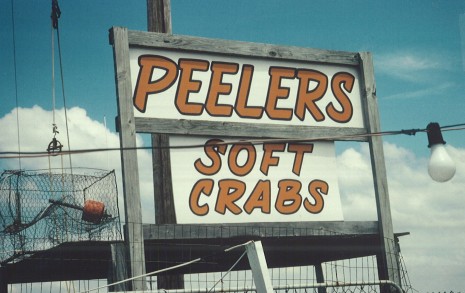SOFT-SHELLED CRABS
It’s easy to be extravagant in the spring. Last week, we traveled miles to see carefully tended beds full of tumbling, fragrant old-garden roses. And this week, we traveled miles to eat soft-shelled crab.
I know sweet, succulent soft-shells are available here in New York, but every June I feel compelled to pick up and go to the Chesapeake Bay, the largest estuary in the United States and synonymous with the blue crab, Callinectes sapidus (literally, “savory swimmer”). This year, the Bay experienced a harrowing winter, and crab mortality was high. Still, according to the latest dredge survey conducted by the Virginia Institute of Marine Science (VIMS) and the Maryland Department of Natural Resources, blue crab stocks, above their target for the third year in a row, are climbing back from a precipitous decline. We got in the car and headed south to visit friends on the Eastern Shore—and polish off a whole mess of crabs.
The key to deciphering roadside signs in that part of the world is basic biology. A peeler is a crab that is just about ready to commence shedding (molting) its hard outer shell—anatomically speaking, its exoskeleton. A buster has begun to back out of its carapace but hasn’t kicked it completely free. Every time a blue crab sheds its shell, it increases its overall size by about a third, and it might cycle through the process 20 times during its three- to four-year life span.
Commercial watermen will protect peelers and busters in shedding tanks until they leave their shells behind. Once a crab has busted loose, so to speak, it’s termed a soft-shell. Because this stage only lasts for a few hours, a soft-shell is immediately removed from the water to prevent its shell from hardening.
Soft-shells are highly perishable, so cooking them involves buying them live and dressing—i.e., cleaning—them. This procedure is gruesome to the uninitiated (and it’s something you can ask the fishmonger to do), but, perhaps because it’s something I’ve been around all my life, I can’t get too worked up about it. Crabs, after all, are scavengers. They will eat anything, even me, given the chance. Luck of the draw.
Our friends’ summer cabin is on the primitive side, with sturdy cots for sleeping and cans of OFF! within easy reach. The airy kitchen is equipped with a few ancient pots and pans as well as an equally ancient range. We used kitchen shears to snip off the crabs’ eyestalks and mouth, taking out their central nervous system in one fell swoop. We removed the sand sac (stomach), which can contain grit, and the “mustard,” actually a digestive gland called the hepatopancreas. Lots of people savor its assertive taste, but since that’s where any contaminants will be concentrated, it’s usually best to discard it. The spongy-looking gills and the apron (abdomen), on the underside of the crab, were the last things to go. Once rinsed under cold water and patted dry, the crabs were ready for cooking, and we were ready to dig into the cooler of iced beer.
The rest of dinner wasn’t complicated—green beans tossed with a shallot vinaigrette and Parker House rolls, baked the day before by Sam and freshened in the oven. Soon, with two skillets working on the stovetop, we started sautéing batches of soft-shells to order. I didn’t write anything down, but the following recipe will give you a general idea of how to cook not just soft-shells, but almost any kind of seafood à la meunière, or “miller’s wife style”—that is, with floury hands. The finishing touch is a quick pan sauce of brown butter, parsley, and lemon. It is infinitely versatile: Try substituting chervil for the parsley.
Sautéed Soft-Shelled Crabs
Serves 4
We used all-purpose flour for dredging, but finely milled Wondra, the secret to silky-smooth gravies and sauces, gives the crabs’ delicate crust more finesse. If you prefer a little crunch, use quick-cooking Cream of Wheat instead of flour; it’s a technique I learned from chef—and Top Chef Master—Floyd Cardoz while working on his book, One Spice, Two Spice. If you’re worried that the crab shells might be a little tough, soak the soft-shells briefly in milk before dredging.
All-purpose flour
Salt and freshly ground pepper
8 medium live soft-shells, dressed (see above), rinsed, and patted dry
Canola oil
Unsalted butter
Fresh lemon juice
Finely chopped fresh parsley
Spoon about a cup of flour in a pie plate and season generously with salt and pepper. Gently dredge the soft-shells, one at a time, in the seasoned flour, shaking off the excess. In a large heavy skillet, heat about 2 tablespoons oil and about 1 tablespoon butter over moderately high heat until shimmery. Add half the crabs, upside down, and cook until they’re golden brown, about 2 minutes. Turn them over and cook them until crisp and golden brown on the other side, a few minutes more. Drain the crabs on brown paper and cook the remaining soft-shells in the same way.
Wipe out the skillet with a paper towel and add a nice chunk of butter. Let it cook, still over moderately high heat, until it is a rich golden brown and has a nutlike aroma. You will know it’s done when people run into the kitchen exclaiming, “What smells so good?” Spritz in some lemon juice and add the parsley. Pull the pan off the heat, taste the sauce, and tinker with the seasonings if necessary.
Serve the soft-shells immediately, drizzled with the sauce. Clink glasses and make a toast: “Same time next year!”
Posted: June 14th, 2011 under cooking, obsession, people + places, recipes, spring.



Comment from Tracy
Time August 3, 2011 at 10:54 am
Being from Maryland (Baltimore), I loved this post. We love our bay. We love our crabs. So glad you do too 🙂